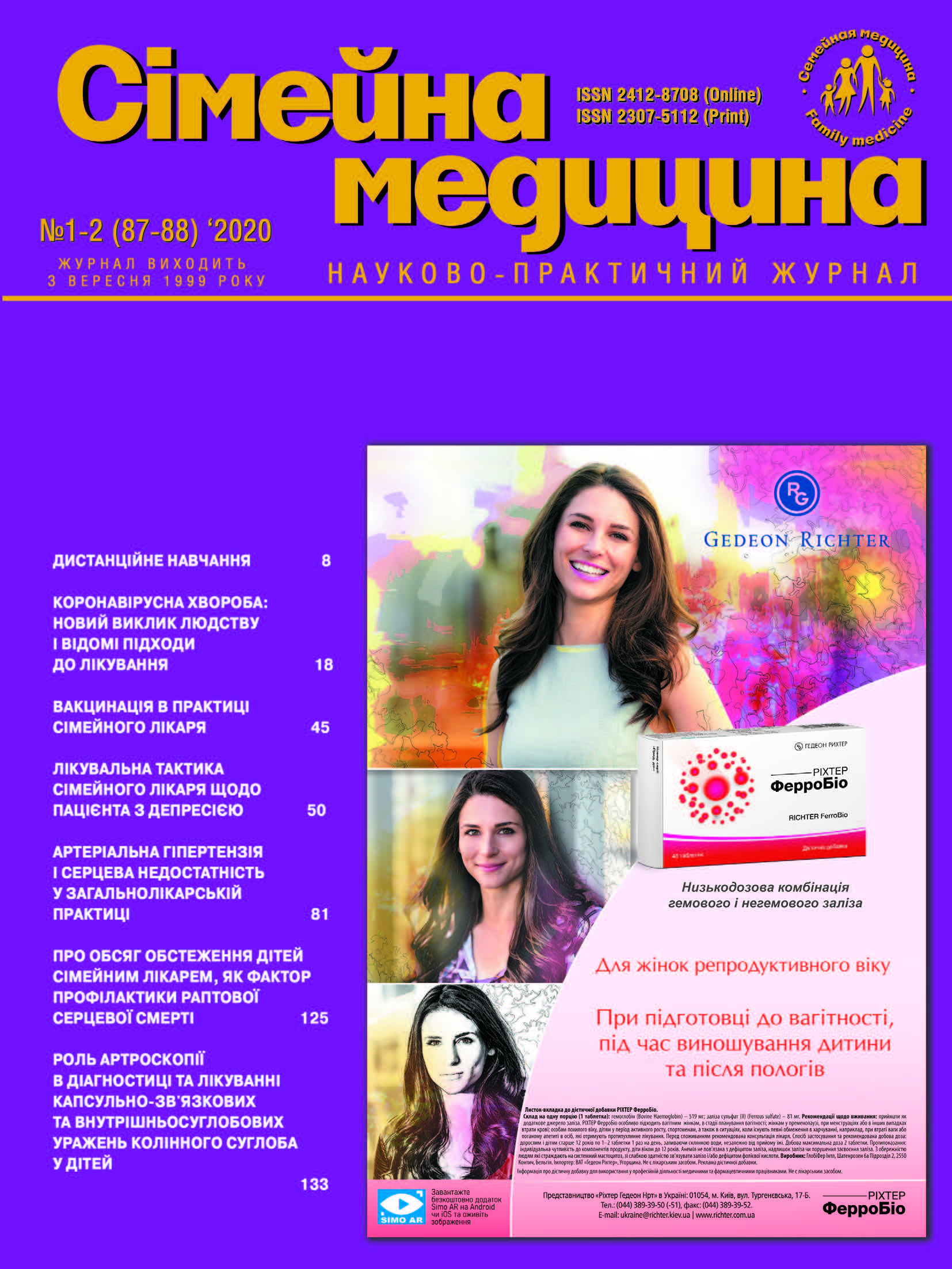Interrelation Between Disorder of Melatonin-forming Function of Epiphysis and Dyslipidemia in Patients with Chronic Kidney Disease of 5 Stage Treated by Hemodialysis
##plugins.themes.bootstrap3.article.main##
Abstract
The results of a number of studies have proved the relationship between the functional state of the pineal gland and renal function. However, violations of the melatonin-forming function of the epiphysis (MFE) in patients with chronic kidney disease (CKD) undergoing hemodialysis (HD) and its relationship with dyslipidemia in this patient population is a poorly understood issue.
The objective: to analyze disorders of MFE and blood lipid spectrum in patients with CKD of 5 stage treated with HD and to determine the relationship of epiphysis dysfunction with dyslipidemia.
Materials and methods. 130 people (50% of men) aged 58.5 were surveyed [43; 66] which are on permanent hemodialysis treatment. Control passed 20 healthy individuals. The determination of day and night level of melatonin (MT) in saliva was conducted, based on the level of which patients (treated with HD) were divided into two groups: group I – 110 patients with impaired MFE, group II – 20 patients with normal MFE. Clinical and laboratory researches were carried out for all patients: general and biochemical analyzes of blood with determination of cholesterol level and its fractions, measurements of office blood pressure (BP) were made.
Results. Significant prevalence of MFE disorders in patients with CKD of 5 stage treated with hemodialysis and its relationship with blood lipid spectrum were found. The level of total cholesterol (TC), triglycerides (TG) and low density lipoproteins (LDL) in patients with impaired MFE was higher by 26.4 % (p<0.05), 16.7 % (p<0.05) and 22 , 6 % (p= 0.03) according to the outcome of the comparison group patients. The level of high-density lipoprotein (HDL) of the main group is lower by 11.8 % compared to the group with preserved MFE. The data obtained indicate the relationship of MFE disorders with the duration of RRT treatment, the duration of arterial hypertension, the age of patients, and their effect on the lipid spectrum of patients with CKD of 5 stage treated with hemodialysis. Night feedback correlation of MT with TC level was established (r=–0.256; p<0.05). Correlation analysis confirms that a decrease in MT at night is combined with an increase of TG level (r=–0.272; p<0.05) in the blood of patients. The feedback correlation of night (r=–0.347; p=0.03) and daytime level (r=–0.198; p<0.05) of MT with LDL level and positive relationships between MT in daytime (r=0.27; p=0.03) and the night period (r=0.331; p=0.02) with HDL levels.
Conclusion. For patients with CKD of 5 stage undergoing hemodialysis, there is a frequent violation of MFE (84.6 %) and significant disorders of lipid metabolism (58 %). Analysis of the lipid metabolism study revealed more profound abnormalities in the form of an increased concentration of TC and all its fractions in patients with impaired MFE, which may indicate a connection between epiphysis dysfunction and lipid metabolism in patients with RRT. In patients with hemodialysis, melatonin-forming dysfunction and disorders of lipid metabolism are age dependent and are determined by the duration of RRT, the duration of hypertension, the level of hemoglobin. We have identified a relationship between the deterioration of lipid metabolism on the background of deeper disturbance of MFE by daytime and nighttime MT.##plugins.themes.bootstrap3.article.details##

This work is licensed under a Creative Commons Attribution 4.0 International License.
Authors retain the copyright and grant the journal the first publication of original scientific articles under the Creative Commons Attribution 4.0 International License, which allows others to distribute work with acknowledgment of authorship and first publication in this journal.
References
Abrass C.K. 2004. Cellular lipid metabolism and the role of lipids in progressive renal disease. Am. J. Nephrol. 24:46-53.
Bhowmik D., Tiwari S.C. 2008. Metabolic syndrome and chronic kidney disease. Indian J. Nephrol. 18(1):1-4
Chen S.C., Hung C.C., Kuo M.C. et al. 2013. Association of dyslipidemia with renal outcomes in chronic kidney disease. PLoS One. 8(2): Е55643.
Colina I.B. 2012. Hyperli pidemia in patients with chronic kidney disease: features and approaches to treatment. The attending physician. 1:63-70.
Fellstrom B. C., Jardine A. G., Schmieder R. E. et al. 2009. Rosuvastatin and cardiovascular events in patients undergoing hemodialysis. N. Engl. J. Med..360 (14):1395–1407.
Hopkins P.N. 2013. Molecular biology of atherosclerosis. Physiol. Rev. 93(3):1317–1542.
Hrenak J, Paulis L, Repova K, Aziriova S, Nagtegaal EJ, Reiter RJ et al. 2015. Melatonin and renal protection: novel perspectives from animal experiments and human studies (review). Curr Pharm Des..21(7):936-49.
Keane WF, Tomassini JE, Neff DR. 2013. Lipid abnormalities in patients with chronic kidney disease: implications for the pathophysiology of atherosclerosis. J Atheroscler Thromb. 20(2):123-133.
Mahmoud R Hussein, Omyma G Ahmed, Asmaa F Hassan, and Marwa A Ahmed. 2007. «Intake of melatonin is associated with amelioration of physiological changes, both metabolic and morphological pathologies associated with obesity: an animal model» Int J Exp Pathol. 88(1): 19–29.
Mohsen Mohammadi-Sartang, Mohammad Ghorbani, Zohreh Mazloom. 2017. Meta-analyses: Effects of melatonin supplementation on blood lipid concentrations: A systematic review and meta-analysis of randomized controlled trials. Clinical Nutrition. 1-12
Nikolaev A.Ju. 2000. Osobennosti dializnoj gipertonii. Nefrologija. 4(1):96-98.
Omran J, Al-Dadah A, Dellsperger KC. 2013. Dyslipidemia in patients with chronic and end-stage kidney disease. Cardiorenal Med. 3(3):165-177.
Slawik H., Stoffel M., Riedl L. 2016. Prospective Study on Salivary Evening Melatonin and Sleep before and after Pinealectomy in Humans. J. Biological Rhythms. 31(1):82-93.
Smirnov, A.V. 2006. Jepidemiologija i social’no-jekonomicheskie aspekty hronicheskoj bolezni pochek. Nefrologija. (10)1:7—13.
Sun H, Huang F-f, Qu S. 2015. Melatonin: a potential intervention for hepatic steatosis. Lipids Health Dis. 14(1):75.
Vaziri N.D., Norris K. 2011. Lipid disorders and their relevance to outcomes in chronic kidney disease. Blood Purif. 31(1–3):189-96.
Vaziri N.D. 2006 Dyslipidemia of chronic renal failure: the nature, mechanisms, and potential consequences. Am J Physiol Renal Physiol. 290:262–272.
W. N. W. Yusoff, N.A.A. Bakar, S. Muid, A.M. Ali, G. R. A. Froemming, H. Nawaw. 2017 Antioxidant activity of high-density lipoprotein (HDL) using different in vitro assays. J Fundam Appl Sci. 9(6S):298-315.





